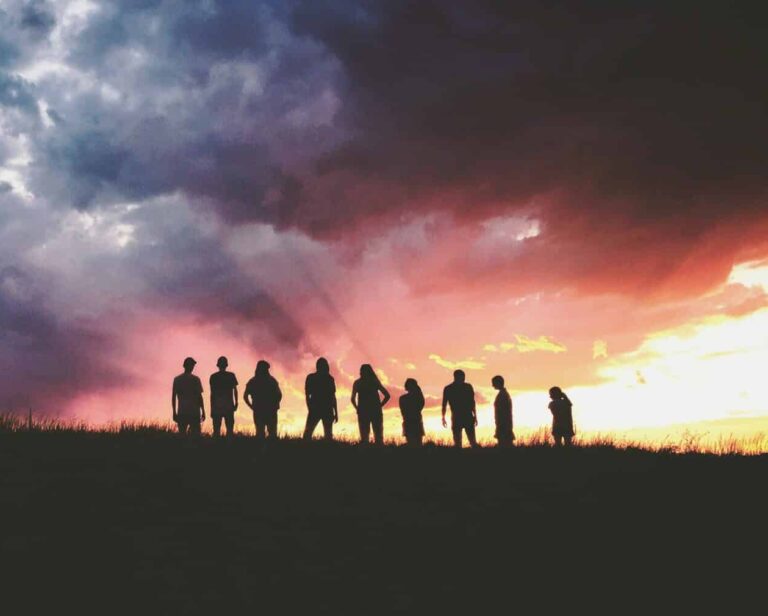I hesitate to call the following blog post a “lesson plan.” That would make it seem like I’ve come up with some amazing material to help you teach a lesson on 3 Nephi 20-26. Instead I found these passages of scripture to be a little like swimming through a lake of deep doctrine. Each lap across the lake left me feeling breathless and overwhelmed. I feel doctrinally out of my depth to fully explain the passages.
However, I did study and ponder these chapters for several weeks and I want to share what I’ve been thinking about. Consider the things that I talk about here to be a rough guide across the lake of deep doctrine.
If you feel like you have better or additional insight into these chapters please consider writing a guest post or your own lesson plan. I’d love to have more resources for navigating the doctrine in these chapters.
As I’ve gone over 3 Nephi chapters 20-26 I’ve had a few observations. I want to share them with you.
Observation #1: This is the second day of Jesus’s visit to the Nephites. On this day he administers the sacrament and then launches into teaching about His covenant relationship with the House of Israel. He quotes from Old Testament prophets like Micah, Isaiah, and Malachi. He even throws in a reference to things that were said in Acts. This is a day of deep doctrine.
What’s interesting is that he tried to start teaching these things on the first day. Back in 3 Nephi 16 he begins quoting Isaiah 52. Then he looks at the people and perceives that they are just not ready for this. He tells them to go home and rest. He will be back the next day. However, He realizes that they don’t want Him to leave. This is when He has them come to Him and he heals them one by one. He also takes time to pray over and bless the children.
I want you to keep that interaction in mind as you read through the teachings from the second day. These second day teachings were given to people who had been healed by Jesus and had some powerful spiritual experiences. If you start studying these chapters and feel overwhelmed and just not ready for the deep theological exercise – that’s okay. Jesus made sure the people had rested and had physical needs looked after before he taught the people these things.
You too can take a break and look after your physical needs before reading these things. Perhaps that means you start your study tomorrow – or maybe you set this section aside until we come back to it again in four years. That’s okay.
Observation #2: We don’t have all the teachings of Jesus from this section. We have the record of the scriptures that he quoted to the people. But we don’t have the record when he “expounded” or explained what those scripture passages meant in full.
Mormon says that he was about to write all the things that Jesus taught, “but the Lord forbade it, saying ‘I will try the faith of my people.'” (3 Nephi 26:11)
And frankly I feel a little cheated by that. This whole lesson plan would be a lot easier to write if I knew what direction Jesus took his explanations. I guess we are meant to just work with what we have here.
Observation #3: There’s a lot of unfamiliar stuff in these passages. I’ve read through these chapters 5 or 6 times over the past few weeks. I’ve read commentaries and relied heavily on the footnotes in my Annotated Book of Mormon and I feel like I’m barely starting to get my bearings.
There are a few familiar passages. Malachi’s chapters talking about robbing God through not paying tithes and offerings as well as the familiar phrase, “turn the hearts of the children to the fathers” show up toward the end. The Come Follow Me manual dedicates quite a bit of time to those phrases. The manual has a whole section about tithing and another about family history.
At first I was annoyed that the manual was trying to shoehorn tithing and family history into this lesson. But at this point I kind of understand. Those topics are easy compared to some of the deeper stuff about God’s covenant relationship with his people. When you are trying to swim through a sea of deep doctrine it makes sense that you’d want to grab onto the buoys of familiar topics like tithing and family history.
Observation #4: It’s helpful to look at the the big picture of these chapters. Jesus is talking about prophecies that are yet to be fulfilled. This is talking about the last days. The gospel will be preached to the Gentiles, some will believe while others do not, God’s judgements will come to the unrepentant Gentiles. The repentant Gentiles will become part of the House of Israel. A New Jerusalem will be built in this land.
There’s a lot of fancy phrasing and some odd word choices, but that’s the big picture. If you get lost just keep that in mind.
—-
At this point you might be wondering why I’m even trying to write a lesson plan about 3 Nephi 20-26.
The whole reason I even signed up for these chapters has to do with a passage from Isaiah. All year I’ve been on my own scripture study plan separate from the Come Follow Me curriculum. I’ve been studying the book of Mosiah. I’ve gone through one chapter a week with a few breaks built into the timeline.
I’ve learned a lot of things studying scripture at a slower pace. Perhaps the biggest surprise was how much of my study in Mosiah would be spent on a particular passage from Isaiah. Isaiah 52:7-10 plays a prominent role in the teachings of Abinadi.
I dug deeply into what it all meant and even wrote a blog post about interpreting that passage of Mosiah through Abinadi’s teachings. I really had my eyes opened to the meaning of that passage. Then I figuratively dusted off my hands and thought, “well, that’s the last of that passage.”
Then I happened to look at one last footnote and realized that Isaiah 52:7-10 comes up again in 3rd Nephi. Jesus quotes it while he is visiting the Nephites.
I realized I wasn’t done with this passage yet.
I signed up for this lesson plan specifically to dig into what this passage is doing in 3rd Nephi and how we can understand it in light of the other teachings of Jesus in the chapters surrounding it. I thought it would be simple. After all, I’d done all that earlier study on Isaiah 52:7-10.
However, it’s not just Isaiah. Jesus also quotes from Micah, Acts, and Malachi. Actually, quoting isn’t quite the right word. Is riffing a word that you can associate with scripture? Because that’s kind of what’s going on here. Jesus uses the basic phrasing, but some words are changed. Whole passages are presented in a different order. He quotes from Micah chapter 5 and then immediately quotes from Micah chapter 4. His delivery of Isaiah 52 has verses all over the place. He quotes verses 8-10 followed by verses 1-3, then verses 6-7 followed by verses 11-14. I’m sure there is meaning to all of this, but but it’s beyond my abilities at the moment.
So let’s bring this back to the basic passage: Isaiah 52:7-10. I may not understand what exactly is happening in all the details of this lesson. But I can explain this one scripture.
At the end of 3 Nephi 16 Jesus quotes Isaiah 52: 8-10.
Thy watchmen shall lift up the voice;
with the voice together shall they sing,
for they shall see eye to eye when the Lord shall bring again Zion.
Break forth into joy,
Sing together, ye waste places of Jerusalem;
for the Lord has comforted his people,
He hath redeemed Jerusalem,
The Lord hath made bare his holy arm in the eyes of all the nations;
and all the ends of the earth shall see the salvation of God.
He quotes it again in 3 Nephi 20: 32-34. There is a little bit of preamble in verses 30-31. Jesus says, “And it shall come to pass that the time cometh when the fulness of my gospel shall be preached unto them; and they shall believe in me, that I am Jesus Christ, the Son of God, and shall pray unto the Father in my name. “
From this we can understand that the following verses are about how people will react when the fullness of the gospel is preached and when people believe in Jesus. That helps us understand the same Isaiah passages with some new phrasing added.
Then shall their watchmen lift up their voice;
and with the voice together shall they sing,
for they shall see eye to eye.
Then will the Father gather them together again,
and give unto them Jerusalem for the land of their inheritance;
then shall they break forth into joy.
Sing together, ye waste places of Jerusalem,
for the Father has comforted his people,
he hath redeemed Jerusalem.
The Father hath made bare his holy arm in the eyes of all the nations;
and all the ends of the earth shall see the salvation of the Father;
And the Father and I are one.
A few verses later he quotes from Isaiah 52:7 which is actually the beginning to the passage. Abinadi also quoted this verse out of order when he was explaining the passage to the priests of Noah. It reads,
“How beautiful upon the mountains are the feet of him that bringeth good tidings unto them;
that publish peace;
that bringeth good tidings unto them of good;
that publish salvation;
that saith unto Zion, “Thy God reigneth!”
Abinadi did an amazing job explaining this part of the passage. He laid out a fabulous explanation that explained that this passage applied to those who preached of Jesus in the past, the present, and the future. He then took it one step forward and explained that this passage was also about Jesus himself. (For a more detailed look at Abinadi’s teachings on this passage go read my blog post titled “Who has Beautiful Feet.)
Jesus is talking about this in a sightly different way. It still is about those who testify of Him. But it’s also about the future. It’s about how the gathering of Israel is good news.
Jesus will go on to quote many more things about the gathering of Israel. He’ll use more quotes from Isaiah 52 and 54. He’ll quote more of Micah 5. He’ll quote Malachi 3 and 4. There are a lot of details in those passages. I’m not able to explain them now, but I’ll be thinking about them. Maybe in four years I’ll be a better equipped theologian who can dig into the deep doctrine and the references to ancient scripture.
I may not know a lot about all of this yet, but I do know one thing. The gathering of Israel is meant to fill us with joy. We are meant to sing. We are meant to see eye to eye. There will be comfort and there will be redemption. All the ends of the earth will see salvation.
The title of this chapter in Come Follow Me is “Ye are Children of the Covenant.” I think it’s important to remember that being part of the covenant is supposed to bring us joy. It’s meant to be good tidings of good.
So even though this is a complicated group of scriptures we can look at it through the angle of joy and happiness.






One Response
I love your lens of joy and happiness, thank you Ann!